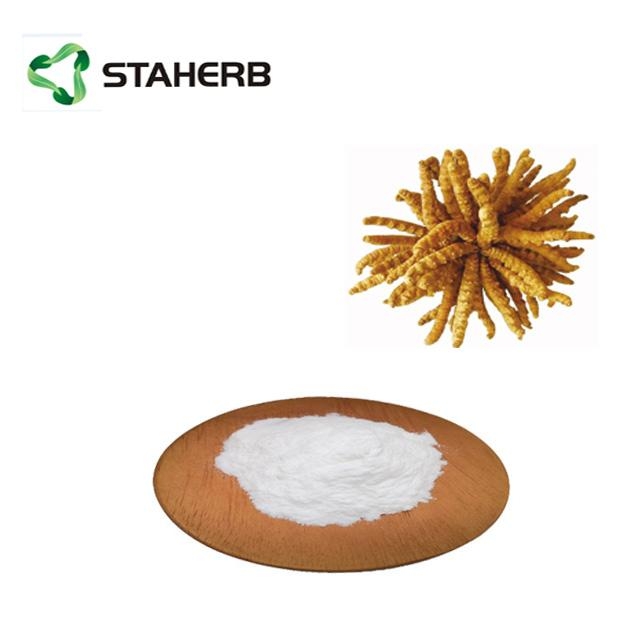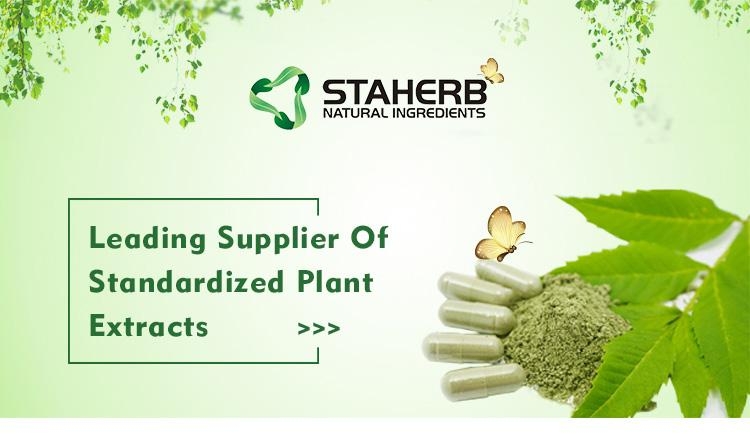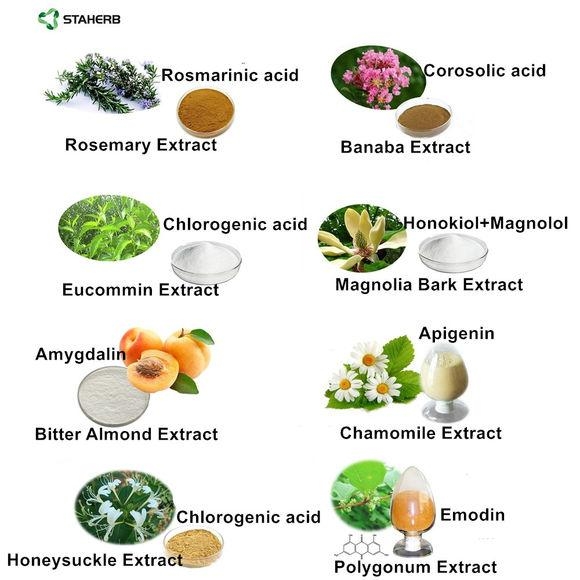
虫草素
品名:虫草素
CAS號.: 73-03-0
分子式: C10H13N5O3
分子量: 251.24
純度:≥1%-98%
檢測方式:HPLC-DAD or/and HPLC-ELSD

虫草素又稱冬虫夏草素、虫草菌素、蛹虫草菌素,別名3′-脫氧腺苷,是 個從真菌中分離出來的核苷類抗生素。
目前研究結果表明,虫草素具有肺腎的保護性、抗三高、抗腫瘤、神經保護性、抗炎、抗氧化和免疫調節等生物活性。因此,虫草素在抗衰老、保健、新藥研製等領域備受學者關注
理化性質:
虫草素的分子式為C10H13N5O3,相對分子質量為251.25,能溶于水,乙醇,虫草素為含氮配糖體的核酸啣生物,屬嘌呤類生物碱;
虫草素化學性質:
熔點:225-229°C
比旋光度: D20 -47°; D27 -42°
沸點:394.4°C
密度:1.2938
折射率:1.7610
儲存條件:−20°C
產品詳詢:13657416805

References:
- 1.
Cui, J. D. (2015) Biotechnological production and applications of Cordyceps militaris, a valued traditional Chinese medicine. Critical Rev. Biotechnol. 35: 475–484.
- 2.
Fung, J., G. Yue, K. P. Fung, X. Ma, X. Q. Yao, and W. H. Ko (2011) Cordyceps militaris extract stimulates Cl(-) secretion across human bronchial epithelia by both Ca(2+)(-) and cAMPdependent pathways. J. Ethnopharmacol. 138: 201–211
- 3.
Tuli, H., S. Sandhu, and A. Sharma (2013) Pharmacological and therapeutic potential of Cordyceps with special reference to cordycepin. 3 Biotech. 4: 1–12.
- 4.
Ueda, Y., K. Mori, S. Satoh, H. Dansako, M. Ikeda, and N. Kato (2014) Anti-HCV activity of the Chinese medicinal fungus Cordyceps militaris. Biochem. Biophys. Res. Commun. 447: 341–345.
- 5.
Wasser, S. (2014) Medicinal mushroom science: Current perspective, advances, evidences and challenges. Biomed. J. 37: 345–356.
- 6.
Lennon, M. B. and R. J. Suhadolnik (1976) Biosynthesis of 3’-deoxyadenosine by Cordyceps militaris. Mechanism of reduction. Biochim. Biophysic. Acta 425: 532–536.
- 7.
Xiang, L., Y. Li, Y. Zhu, H. Luo, C. Li, X. Xu, C. Sun, J. Song, L. Shi, L. He, W. Sun, and S. Chen (2014) Transcriptome analysis of the Ophiocordyceps sinensis fruiting body reveals putative genes involved in fruiting body development and cordycepin biosynthesis. Genom. 103: 154–159
- 8.
Yin, Y., G. Yu, Y. Chen, S. Jiang, M. Wang, Y. Jin, X. Lan, Y. Liang, and H. Sun (2012) Genome-wide transcriptome and proteome analysis on different developmental stages of Cordyceps militaris. PLoS One 7: 51853.
- 9.
Zheng, P., Y. Xia, G. Xiao, C. Xiong, X. Hu, S. Zhang, H. Zheng, Y. Huang, Y. Zhou, S. Wang, G. P. Zhao, X. Liu, R. J. St. Leger, and C. Wang (2011) Genome sequence of the insect pathogenic fungus Cordyceps militaris, a valued traditional Chinese medicine. Genome Biol. 12: R116.
- 10.
Ni, H., X.H. Zhou, H. H. Li, and W. F. Huang (2009) Column chromatographic extraction and preparation of cordycepin from Cordyceps militaris waster medium. J. Chromatogr. B 877: 2135–2141.
- 11.
Rottman, F., M. L. Ibershof, and A. J. Guarino (1963) Studies on the synthesis and structure of cordycepin monophosphate. Biochim. Biophysic. Acta 76: 181–187.
- 12.
Wang, H., M. Pan, C. Chang, S. Chang, and W. Hseih (2014) Optimization of ultrasonic-assisted extraction of cordycepin from Cordyceps militaris using orthogonal experimental design. Molecules 199: 20808–20820.
- 13.
Zhou, X., Z. Gong, Y. Su, J. Lin, and K. Tang (2009) Cordyceps fungi: Natural products pharmacological functions and developmental products. J. Pharm. Pharmacol. 61: 279–291.
- 14.
Das, S. K., M. Masuda, M. Hatashita, A. Sakurai, and M. Sakakibara (2010) Optimization of culture medium for cordycepin production using Cordyceps militaris mutant obtained by ion beam irradiation. Proc. Biochem. 45: 129–132.
- 15.
Masuda, M., E. Urabe, H. Honda, A. Sakurai, and M. Sakakibara (2007) Enhanced production of cordycepin by surface culture using the medicinal mushroom Cordyceps militaris. Enz. Microb. Technol. 40: 1199–1205.
- 16.
Das, S. K., M. Masuda, M. Hatashita, A. Sakurai, and M. Sakakibara (2008) A new approach for improving cordycepin productivity in surface liquid culture of Cordyceps militaris using high energy ion beam irradiation. Lett. Appl Microbiol. 47: 534–538.
- 17.
Tang, Y. J. and J. J. Zhong (2003) Scale-up of a liquid surface culture process for hyperproduction of ganoderic acid by the medicinal mushroom Ganoderma lucidum. Biotechnol. Prog. 19: 1842–1846.
- 18.
Kang, C., T. C. Wen, J. C. Kang, Z. B. Meng, G. R. Li, and K. D. Hyde (2014) Optimization of large-scale culture conditions for the production of cordycepin with Cordyceps militaris by liquid surface culture. The Scientific World J. 2014: 510627.
- 19.
Mao, X. B. and J. J. Zhong (2004) Hyperproduction of cordycepin by two-stage dissolved oxygen control in submerged cultivation of medicinal mushroom Cordyceps militaris in bioreactors. Biotechnol. Prog. 20: 1408–1413.
- 20.
Dong, J. Z., M. R. Lui, C. Lei, X. J. Zheng, and Y. Wang (2012) Effects of selenium and light wavelengths on liquid culture of Cordyceps militaris link. Appl. Biochem. Biotechnol. 166: 2030–2036.
- 21.
López, F. N., M. C. Quintana, and A. G. Fernández (2006) The use of a D-optimal design to model the effects of temperature, NaCl, type and acid concentration on Lactobacillus pentosus IGLAC01. J. Appl. Microbiol. 101: 913–926.
- 22.
Piccolomini, A. A., A. Fiabon, M. Borrotti, and D. De Lucrezia (2016) Optimization of thermophilic trans-isoprenyl diphosphate synthase expression in Escherichia coli by response surface methodology. Biotechnol. Appl. Biochem. DOI: 10.1002/bab.1459
- 23.
Srikanth, R., G. Siddartha, C. H. Sundhar Reddy, B. S. Harish, R. M. Janaki, and K. B. Ramaiah (2015) Antioxidant and antiinflammatory levan produced from Acetobactor xylinum NCIM2526 and its statistical optimization. Carbohyd. Polym. 123: 8–16.
- 24.
Zhou, Q., J. Su, H. Jiang, X. Huang, and Y. Xu (2010) Optimization of phenazine-1-carboxylic acid production by a gacA/ qscR-inactivated Pseudomonas sp. M18GQ harboring pME6032Phz using response surface methodology. Appl. Microbiol. Biotechnol. 86: 1761–1773.
- 25.
Zheng, Z. L., X. H. Qiu, and R. C. Han (2015) Identification of the genes involved in the fruiting body production and cordycepin formation of Cordyceps militaris fungus. Mycobiol. 43: 37–42.
- 26.
Das, S. K., M. Masuda, A. Sakurai, and M. Sakakibara (2009) Effects of additives on Cordycepin production using a Cordyceps militaris mutant induced by ion beam irradiation. Afr. J. Biotechnol. 8: 3041–3047.
- 27.
Mao, X. B., T. Eksriwong, S. Chauvatcharin, and J. J. Zhong (2005) Optimization of carbon source and carbon/nitrogen ratio for cordycepin production by submerged cultivation of medicinal mushroom Cordyceps militaris. Proc. Biochem. 40: 1667–1672.
- 28.
Mao, X. B. and J. J. Zhong (2006) Significant effect of NH4 + on cordycepin production by submerged cultivation of medicinal mushroom Cordyceps militaris. Enz. Microb. Technol. 38: 343–350.
- 29.
Shih, I. L., K. L. Tsai, and C. Hsieh (2007) Effects of culture conditions on the mycelial growth and bioactive metabolite production in submerged culture of Cordyceps militaris. Biochem. Eng. J. 33: 193–201.
- 30.
Masuda, M., E. Urabe, A. Sakurai, and M. Sakakibara (2006) Production of cordycepin by surface culture using the medicinal mushroom Cordyceps militaris. Enz. Microb. Technol. 40: 1199–1205.
- 31.